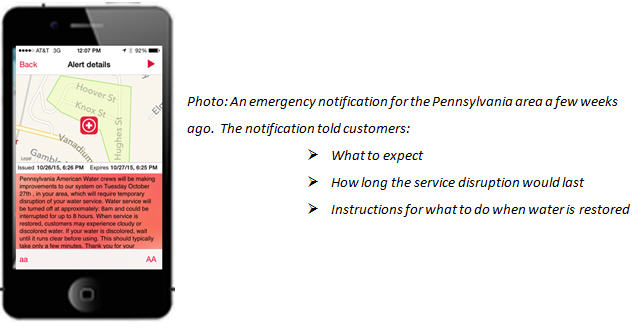Recap: American Water Shares Expertise At NARUC Annual Meeting

Earlier this month, American Water, the largest, most geographically diverse investor owned water and wastewater utility in the U.S., played an active role in the National Association of Regulatory Utility Commissioners’ (NARUC) 127th Annual Meeting,* which was held in Austin, TX. The meeting brought together commissioners from across the country with other subject matter experts to examine key issues, challenges, and opportunities — for consumers, service providers, and public officials — through the convergence of traditional utility services in the energy, water, and advanced communications sectors.
First, Jim Jenkins, vice president of Rates & Regulatory Policy at American Water, helped kick off the meeting by participating in a panel titled "Convergence Consortium." He joined other leading subject matter experts who briefed the consortium on recent developments, highlighted emerging issues, and identified possible areas of inquiry, including:
- How telecommunications interact with all utilities, with smart meters, energy management systems, cell phones, and broadband;
- How to work together on issues of data quality, privacy, and security — physical as well as cyber; and
- Changes in the traditional utility model with new options for personal choice, distributed generation, and 24/7 technology.
“As we look at convergence, it’s important to recognize that water, energy, and telecommunications companies all serve the public, and we often share customers and service territories,” noted Jenkins. “What’s more, our services are very interdependent with 13 percent of U.S. energy consumption being water-related, which is roughly the energy required to serve 40 million Americans. Water is needed for energy: to process gasoline, to fracture shale, and to cool thermoelectric plants. Telecom is the glue that holds our many remote operations together.”
At American Water, for example, there are: 6,800 employees operating in 15 states and 200 locations; 2,400 trucks that are driven; 3.2 million customer connections; and more than 250 community water systems that are monitored. Being able to dispatch work, communicate meter readings, and stay in touch with vital operational support throughout the business requires a strong telecommunications network.
With so much in common and so many interdependencies, convergence is all about asking “How can we leverage this for our customers?”
Next on the agenda, President of New York American Water Brian Bruce participated in a panel titled “Leveraging Technology for Customer Engagement,” moderated by the Honorable Art Graham, Chairman of the Florida Public Service Commission.
The panel explored the need for a better understanding and deeper relationship between the water utility and customer. An overarching theme of the panel was how technology plays a role in educating on the value of water and building the underlying customer experience. The discussion focused on targeted communications including real-time notifications, tools for improving customer service, increasing digital penetration — for customer communications and increasing rates of online bill pay. The panel also discussed how to change customer behavior, the role of technology in conservation and empowering the customer to control use and spend.
Bruce highlighted American Water’s partnership for a new, free app for customers called “Code Red.” It provides a variety of emergency updates based on the customers’ geographical location. It’s especially good for customers with landlords who may not pass on emergency information.

Bruce also highlighted the importance of social media during severe weather events or emergencies. With 98 percent of the U.S. online population using social media for one out of every five minutes spent online, there’s a tremendous opportunity for utilities to engage their customers in new ways. For example, during Hurricane Sandy many of American Water's customers lost power and relied on these social platforms as a result. The customers also help too. Some monitoring systems are not fully functional during emergencies and customers become the eyes and ears in some areas.
Additionally, social media allows the company to show pictures of situations, so customers understand what’s happening. The company can also respond to customer questions in a quick, low-cost way via social media.
Following that, Don Shields, vice president and director of Engineering for New Jersey American Water, discussed technological advancements and innovative practices being employed to detect and reduce leaks in a panel titled “Advancements in Leak Detection and Pipeline Condition Assessment.”
The integrity of water utility infrastructure is critical in delivering safe and reliable service to customers. Key aspects in maintaining the ability to deliver safe and reliable service to customers involves detection and reduction leaks and assessment of pipeline conditions. Technological advancements and innovative practices are being employed to address these issues.
Shields discussed how American Water is working with Echologics, which uses permanent leak monitoring equipment attached to hydrants to detect leaks before they surface. In West Virginia, deployment of Echologics helped reduce lost water by roughly 3 MGD, or nearly 10 percent of system production in one area. This not only reduces energy consumption and water withdrawals, but it also can make service more affordable by reducing variable production costs.
Next up, American Water’s President and CEO Susan Story joined representatives from industry, consumer advocacy and regulators in a panel titled "Challenges Coast to Coast: Consumers, Convergence, and Change." By focusing on resilience, sustainability, and affordability, this session explored areas where state and federal regulators and industry can work together to address common challenges and examine how regulators can encourage, facilitate, and leverage the convergence taking place in the utility space.
Everyone in the room faces the same core challenges — whether water, electricity, natural gas, or telecom — they all strive to ensure that utility services are safe, reliable, sustainable, and affordable. More so, they are all doing it in an environment that includes huge infrastructure challenges, supply issues, new regulations, climate volatility, cyber security, and rapidly changing consumer expectations.
And while these challenges are significant, there are also many opportunities. Indeed, the U.S. Department of Energy released a report this September called “Accelerate Energy Productivity 2030.” It is a roadmap that compiles the most promising pathways to achieving the goal of doubling energy productivity in the next 15 years. Six key pathways were identified, and one of these was “Water Infrastructure.” It’s clear the lines between utilities are fading in the eyes of regulators and government and that there is an expectation that we will find shared solutions to our problems.
In this new world, utilities are or will soon be interconnected. Delivery of energy and water services is intertwined, after all, and both energy and water service are dependent on a strong telecommunications network and cutting-edge tools.
Story emphasized the importance of working together on security issues and noted that water outages are one of the more disruptive consequences for a community after major disasters.
Story spoke about leveraging relationships to deliver more affordable reliable service to our customers, including pursuing policies and partnerships that promote collaboration. One example is the Partnership for Clean Power Plan (CPP) compliance, which specifically noted that replacing water pumps, aging water equipment, and repairing leaks can all result in efficiencies eligible for CPP compliance.
She also spoke about how utilities can work together through programs that allow the water industry to deliver electrical grid balance. For example, American Water was the first U.S. water utility use the ENBALA smart grid, which sends signals to our variable speed pumps, allowing them to ramp up or down in response to the needs of the grid.
Finally, Rob Raffaele, manager of Information Technology Domain Architecture for American Water, rounded out American Water’s panel sessions by participating in “The Impact of Internet Protocol (IP) — Transition on Electric, Gas, and Water Utilities” panel. This group focused on what, if any, impact there may be to utilities as the telecom providers migrate from legacy wire-line Time-Division Multiplexing services to IP services. Raffaele spoke to the fact that American Water has been ahead of this issue by partnering with AT&T over the last five years. With AT&T at the table, American Water’s Information Technology Services (ITS) and Security teams designed a standard IP-based cellular service that is now in use by 10 regulated states and the company's Security staff. The cellular service has and continues to provide considerable operating expense (OPEX) savings over legacy wire line services. It also allows for greater agility by being very fast to deploy, not bound by geography, and fully monitored by the company’s ITS team.
*NARUC is the national association representing the State Public Service Commissioners who regulate essential utility services in each state. NARUC meetings are key to staying current and engaged in the essential utility sectors, including electricity, natural gas, telecommunications, and water.
